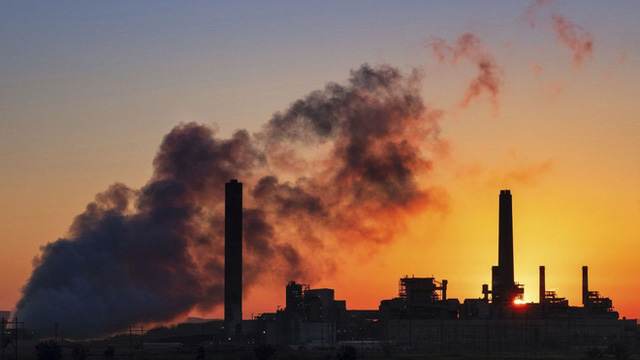Forecast 2020 falls into the top 5 hottest years in history: No El Nino but still hot, why?
- Tram Ho
1. 2020 is on track to be among the top 5 hottest years in history
The National Oceanic and Atmospheric Administration (NOAA) said: Global temperatures in 2020 are on track to become one of the highest global warming years ever recorded.
Specifically, the average global ground and ocean temperature from January to March was 1.15 degrees Celsius, above the average since 1880. The average temperature from January to March 2020 was the second hotest ever recorded in the history of more than 140 years of measurement, only ranked after the first three months of 2016 (2016 is the hottest year in history).
NOAA predicts that 2020 will be a particularly hot year in Eastern Europe and Asia. South America and the Caribbean also show unusual signs of warming.
The latest El Nino event ended in 2019 and the ocean temperatures in the Pacific Ocean are back to normal. However, 2020 is even forecast to be in the top 5 (the 5 hottest years in history – New York Times ) without El Nino, because global warming is still dominated by another factor that is home gas. glass (CO2, CH4, N2O, O3, CFC gases).
The New York Times quoted the scientists as saying: According to the researchers’ probability statistics, it is almost certain that 2020 will rank among the top 10 hot years recorded. The analysis also shows that 49% of the possibility in 2020 is the hottest ever and 98% higher than the likelihood of 2020 being ranked in the top 5.

Emissions from the factory in Glenrock, Wyoming, USA. Photo: J. David Ake / Associated Press
WMO Secretary General Petteri Taalas said: Greenhouse gases will continue to be detrimental to global temperatures. In this context, in 5 years, a new global temperature record is likely to be set.
“It’s just a matter of time. We just had the hottest month in history (January 2020). The unusually mild winters are in many parts of the Northern Hemisphere. Smoke and pollutants from the incidents Australia’s fire has been circulating on a global scale causing a spike in CO2 emissions, record temperatures recorded in Antarctica accompanied by large-scale melting and glacial melting in Greenland. and Antarctica will have catastrophic consequences related to sea level rise. In 2019, the global average sea level reached the highest value in the measurement records . ” – Mr. Petteri Taalas said.
2. 2020: Is the world closer to the brink of climate incidents?
In March 2020, the World Meteorological Organization (WMO) published a multi-agency report on the global climate situation, including two main points:
– The decade 2010-2019 is the warmest decade ever recorded in measurement history.
– 2019 ends with an average global temperature on land and oceans of 1.1 degrees Celsius.
Earlier, the British newspaper The Guardian quoted the National Weather Forecast Center (MET Office) said: Forecast, 2020 may be one of the hottest years in history, with the possibility of temperature. the global will be 1.1 degrees Celsius higher than the pre-industrial average.
Professor Adam Scaife, head of long-term forecasting at MET Office, said natural events, such as El Nino, had an effect on global warming. As a proof, 2016 (when El Nino) was the hottest year in history.
WMO says more than 90% of the excess energy accumulated in the climate system is the result of increasing concentrations of greenhouse gases entering the ocean. In 2019, the ocean heat content to a depth of 2 km exceeded the previous record high set in 2018.
If the NOAA and MET Office forecasts are correct, the world will be closer to the brink of climate incidents in 2020 . Scientists have warned that warming more than 1.5 degrees Celsius above pre-industrial levels will have a detrimental effect on world climate.
The first year the temperature was certified as one degree Celsius higher than the average from 1850 to 1900 was 2015. This speed is increasingly changing rapidly. If the current trend continues, we could break the 1.5-degree threshold within two decades.
High temperatures are an indicator of ongoing climate change. Ocean warming has a wide impact on the climate system and contributes more than 30% of sea level rise through thermal expansion of seawater. It is changing the ocean currents and indirectly changing the path of the storm and melting icebergs. Along with ocean acidification and dehydration, ocean warming can lead to dramatic changes in marine ecosystems.
3. Unpredictable consequences of climate change
The multi-agency report of WMO in March 2020 addresses the impacts of weather and climate on human health, food security, migration, ecosystems and marine life, specifically:
– About health:
In 2019, record high temperatures from Australia, India, Japan and Europe negatively affect human health and well-being.

Extreme weather is negatively affecting human health and well-being. Illustration: Internet
In Japan, a heat wave and heat wave event left more than 100 people dead and an additional 18,000 hospitalizations. In France, more than 20,000 emergency rooms have been recorded for heat-related illnesses between June and mid-September; and during two major summer heatwaves, a total of 1,462 deaths in the affected areas.
Changes in climatic conditions since 1950 are helping Aedes mosquitoes to easily transmit dengue virus, increasing the risk of disease occurrence. In parallel, the incidence of global dengue fever has risen sharply in recent decades and about half of the world’s population is at risk of infection. In 2019, the world experienced a major increase in dengue cases.
– Regarding food security:
Climate change and extreme weather events are one of the main drivers of the recent global increase in hunger.
After a decade of steady decline, famine increased again – more than 820 million people were hungry in 2018. Of the 33 countries affected by the food crisis in 2018, climate change and weather. extremes caused an economic shock and conflict in 26 countries.
The unusually heavy rainfall at the end of 2019 was also a factor in the serious desert grasshopper epidemic in the Horn of Africa – the worst in more than 25 years and the most severe in 70 years for Kenya. This is expected to spread further in June 2020, posing a serious threat to food security.
Source : Genk
